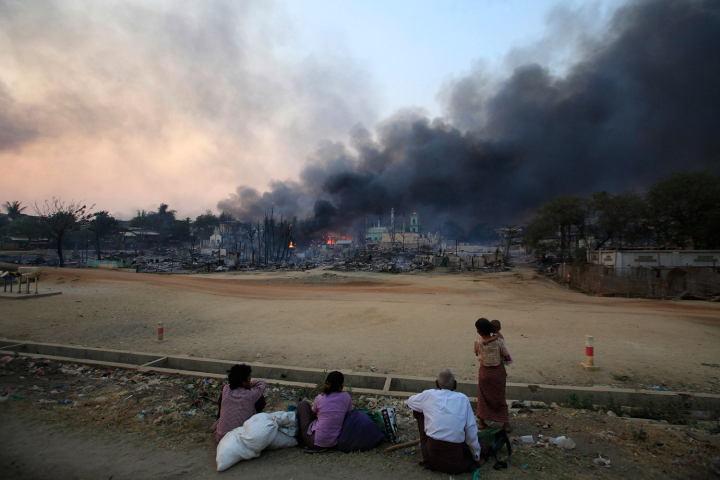
Just hours ago, Burmese President Thein Sein declared a state of emergency in central Burma due to killing, destruction of property, and general rioting in the streets of the town of Meikhtila. Violence erupted following a dispute between a Muslim gold shop owner and Buddhist customers. After four nearby gold shops were burnt to the ground, a 1,000-strong mob of Buddhists ran riot through the Muslim neighborhood. The death toll is currently being reported at at least 20, but this number will likely rise. TIME reports:
Journalists attempting to report in the area have been threatened. A photographer for the Associated Press reportedly had a foot-long dagger placed against his neck by a monk who had his face covered. The confrontation was defused when the photographer handed over his camera’s memory card. Late on Friday, the Burmese government said that nine reporters trapped amid the unrest had been rescued by local police and evacuated from the area.
On social media, residents reported seeing bodies scattered by the side of the road and women and children lying helpless, their homes destroyed. U Aung, a Muslim lawyer living in Meikhtila, told TIME that the violence was already spreading to nearby townships. “They are burning mosques and houses and stealing Muslim property,” said Aung.


Tricycle readers will be familiar with the Buddhist-led violence against the Rohingya Muslim minority in western Burma from the article “Buddhist Nationalism in Burma” in the current issue. In the article, Burmese dissident and democracy activist Maung Zarni makes a convincing argument for the characterization of recent anti-Rohingya violence as genocide. Zarni highlights the harnessing of the same sangha-led forces that occasioned the “Saffron Revolution” (2007) to accomplish these ends.
Recent unrest in Meikhtila suggests two important things. First, anti-Muslim violence and rioting has spread beyond the western Burmese Rakhine state and into the heart of Burma. Second, since the violence appears to be directed at Muslims of Indian origin—not Rohingya Muslims—this would seem to corroborate Zarni’s assertion of the anti-Muslim, religious sentiment of these riots, repeatedly dismissed as “sectarian violence” by many mainstream media outlets at the time of the outbreak of violence last year. (TIME quotes Chris Lew, founder of The Arakan Project: “the perception of last year’s unrest as sectarian rather than religious was inaccurate.”) Zarni makes this contention in his article for Tricycle and reiterated the point when I interviewed him over Skype from Indonesia the day before the last. We also spoke about his objection to the term “communal violence,” which TIME has used in the article quoted above, and the reasons why the conflict hasn’t been called a genocide. The anti-Muslim racism we’re currently witnessing can be tracked back to Burma’s colonial past, which Zarni adumbrates in the article and further elaborates in our interview. Zarni’s article for Tricycle can be found here and our interview will run on the Tricycle blog on Wednesday.
In other news, Ariana Huffington, chair, president, and editor-in-chief of the Huffington Post, has authored an article on corporate mindfulness on her site. Titled “Mindfulness, Meditation, Wellness and Their Connection to Corporate America’s Bottom Line,” the article peddles the benefits of corporate values and its platitudes regarding “performance and productivity”: “I do want to talk about maximizing profits and beating expectations—by emphasizing the notion that what’s good for us as individuals is also good for corporate America’s bottom line.” Most of the piece focuses on cutting healthcare costs to corporations by promoting mindfulness meditation.
Ironically, the research touted here was conducted through a partnership between healthcare behemoth Aetna and Duke University, in which yoga and other mind-body therapies were made available to all Aetna employees nationwide. Apparently, Aetna is not only too cheap to pay their patrons’ medical costs, they’re also too cheap to pay those of their own employees.
The one company that Ariana Huffington reports “gets it,” is Google, whose in-house mindfulness consultant Chade-Meng Tan ensures the happiness of its employees through the stresses and invasiveness of 80-hour workweeks. In such a context, mindfulness reveals itself as the most recent incarnation of industrial psychology, a field of knowledge that has proven effective in pacifying workers and improving their “performance and productivity,” regardless of any inhumane workplace conditions and expectations, or the deleterious effects of their work on the world-at-large (such mindfulness practice has most famously been taught to Monsanto workers).
Huffington ends the article, out of the blue, by quoting Institute for Mindful Leadership founder Janice Marturano: “We have one life. What’s most important is that you be awake for it.” More honest and in keeping with the rest of the article might be, “We have one life. What’s most important is the bottom line.”